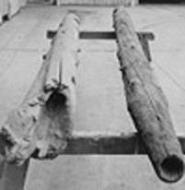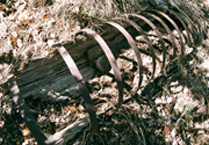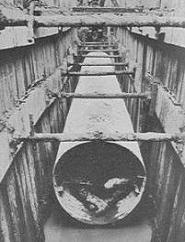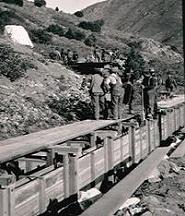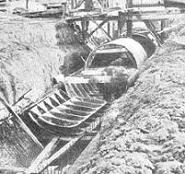Salt Lake City Old Water Conveyance Systems
Early water conveyance systems (1847 - 1909) serve the City’s residents.
LeRoy W. Hooton, Jr.
Originally posted on June 23, 2007
Revised and posted on October 8, 2009
Ditches and Canals
The 28-mile Jordan & Salt Lake City Canal conveyed up to 150 cfs of Utah Lake water to Salt Lake City in 1882
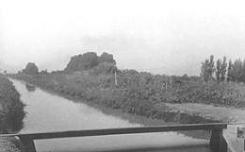
In the early years of Utah, the method of conveying water was through open canals and ditches. The Salt Lake valley pioneers diverted the water from streams into a network of ditches from which the water would be delivered onto the irrigated fields. In Salt Lake City, open ditches traversed each city street providing water to individual lots for irrigation and domestic use. Large scale agriculture endeavors took place outside the city lots. In the Big Field Survey, 5 and 10-acre plots were irrigated by a network of open ditches.
Later, larger canals were dug to convey larger volumes of water to irrigate larger areas of land. The earliest recorded diversions from the Jordan River were in 1850 when the Bennion Mill and Gardner Mill Race diverted 5 and 11 cubic feet per second respectively. In 1853, the North Jordan Irrigation Company extended the Gardner tailrace to a point near Taylorsville, enlarging the canal to carry 125 cubic feet per second to irrigate 8,000 acres of land. The canal was completed in 1881. At turn of the century, there were 7 major canals diverting water out of the Jordan River and Utah Lake.
The first canal dug for municipal purposes was the Jordan and Salt Lake City Canal constructed by Salt Lake City between 1879 - 1882, with a capacity of 150 cubic feet per second. The 28-mile canal provided irrigation and municipal water to Salt Lake City. Later, the canal was used by the City to exchange its Utah Lake water for the farmer's Wasatch mountain water. The first exchange was with the Parley’s Water Users in 1888.
Pioneer Bored Log Pipe
There is evidence that there were early attempts to convey culinary water through bored-out wooden pipes. In a letter on file with the Department of Public Utilities, dated November 14 , 1962, C. E. Painter (Vice President, Construction & Engineering - Water Works Equipment Company) wrote about talking to Water Department assistant superintendent Dow Young (Superintendent 1948-1952) about the Department finding bored wood logs around City Creek. Mr. Young said he did not know who owned them as there was no record in the Salt Lake City minutes regarding bored wood logs. C. E. Painter continued in his letter that information found in the autobiography of Walter Eli Wicox indicated that in 1854 Brigham Young requested that he (Mr. Wilcox) devise a machine for boring logs to convey water to the Endowment House. Mr. Wilcox was successful in constructing a machine to bore the logs, and about a quarter of a mile of bored logs were laid before Brigham Young ordered the work to cease and be abandoned.
Moreover, according to C. E. Painter’s letter, quoting from Mr. Fairclough the grandson of Mr. Wilcox in a history of his grandfather, “He also made a pipeline of logs that carried water from City Creek at North Temple down State Street to the Knutesford Hotel at Third South Street” The pipeline conveyed water to the Salt Lake Theatre [sic], stores and homes on State Street. This log pipeline also failed because pine and resins in the logs affected the taste of the water.
Despite these early failures, as written by his grandson, Eli Wilcox still deserves credit for making the first water pipe for distribution of culinary water in Utah.
|
Wood Stave Pipe in City Creek Canyon
Wood stave pipe was used during the late 1800s to convey water from open ditches to city lots and businesses. It appears that the City’s first effort to construct a water system to convey water supply from City Creek was through wood stave pipe. According to an article in the November, 1920 Municipal Record, written by F. E. Morris (Secretary to Mayor C. C. Neslen ), he wrote that in 1873 a wooden tank (believed to be the Brick Tank) was constructed near the mouth of City Creek canyon and a pipeline of wood was laid to the northeast corner of Main and South Temple streets. “The pipe was of the wooden stave variety bound spirally with ‘hoop’ iron.” Further, he wrote, “Its construction was the occasion for a great public ceremony, being a mammoth undertaking for the small, isolated city with its limited resources.” [This wooden stave pipe was a precursor to the City constructing a pipeline of cast iron in 1876.]
The use of wood stave pipe described by Mr. Morris most likely is same pipe described in the book Heart Throbs of The West, where Ezea T. Stevenson’s journal reads, “The first mains were made by winding spirally in pitch, strips of wood sawn thin enough to have easily round and round. Wooden couplings were made to join the ends.” Stevenson, a contemporary of this era accurately described wood stave pipe. Stevenson added, “And we as youngsters were not long in discovering that pine pitch off the stacked pipes made a reasonably good chewing gum.” [This wood stave pipe could have been the laminated pipe purchased from the Rochester Laminated Pipe and Package Company, NY in 1873.]
|
In Memory Grove there is an exposed section of 12-inch diameter wood stave pipe located on the north side of the embankment below West Capitol Boulevard uphill of the brick tank site. It may be an old irrigation pipeline that conveyed water to the 20th Ward ditch and later abandoned when the 24-inch cast iron pipe was laid from the Pleasant Valley Reservoir in 1892. The observed wood stave pipe parallels the alignment of the current cast iron pipe.
Wood stave pipe was a common pipe material used in the late 1800s. However, with the advent of cast iron pipe, the City for the most part used it in its municipal system.
Salt Lake City’s Piped Municipal Water System
Salt Lake City constructed its first municipal water system between 1874-1976 from City Creek to the downtown business district. Photo circa 1900.
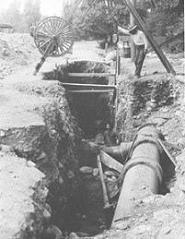
In 1871, Salt Lake City began considering the construction of a piped water distribution system when the City Council passed a resolution to investigate the possibility of such an undertaking. The City Council hired and paid $1,000 to Herman Schussler, Civil & Hydraulic Engineer, to design a system to convey water in a piped system from City Creek to the business district of the City.
In a presentation given to Brigham Young, Mayor Wells and the City Council members on August 12, 1872 Mr. Schussler, reported:
- "The City Creek has for the present & many years to come an abundant supply for Salt Lake City ... I found the creek to deliver in the neighborhood of ten million gallons per diem of 24 hours, which amounts is far in excess of the water required. The average daily consumed through the largest cities in the United States & Europe is 45 gallons per head. Salt Lake counting about 20,000 inhabitants, and a good deal of water being required for irrigation gardens & sprinkling streets, I will assume a daily supply of 100 gallons per head, that is for every man, woman & child, this aggregating a total daily supply of two million gallons. In order to make provisions for the future growth of the City, I propose to construct the pipe system of the City of such dimensions as to be capable of supplying five million gallons per diem.”
- The report goes on to specify the length and size of pipe, fittings and fire hydrants. In regards to the type of pipe, Mr. Schussler noted at this point that the City had already decided to use the laminated wood pipe (approved by the City Council on July 13, 1872), which he noted "is as fully strong and more lasting than Cast Iron, provided the joints are properly secured and made." His statement about laminated wood pipe would later prove wrong.
On August 24, 1872 the City and the Rochester Laminated Pipe and Package Company of Rochester, New York entered into an agreement to secure the pipe and fittings for the City Creek water system. It’s not known what the flaw was with the laminated wood pipe, but its use led to the failure to successfully construct the pipeline.
Two years later, on March 24, 1874 Waterworks Superintendent McKan was authorized by the City Council to dispose of the laminated pipe to the Deseret Agricultural Manufacturing Company Society, in the best terms possible. The next day water superintendent McKan was authorized to go east to find suitable pressure pipe.
During the next six months the City sought out pipe manufacturers in the east to supply pipe for the water works system, finally negotiating with the firm of Dennis Long Company of Louisville, Kentucky to deliver cast iron pipe to Salt Lake City at approximately $70 per ton. The first 20 carloads of 37 arrived in the City on August 3, 1875. Other firms that provided material to install the water works system included David, Howe & Company for fire hydrants; L. J. Rumsey & Company of St. Louis for service pipe and plumbing tools, the Boston Machine Company for water gates and stop and waste cocks, and the Boston Sead Company for tin-lined water pipes.
Work began on the piped system during August 1875 and was completed and placed into operation about a year later, sometime during the summer of 1876.
The piping of water from historic City Creek was a significant milestone for Salt Lake City. It was fitting that City Creek, which provided the original Mormon Pioneers life-giving water would later be diverted into a pressurized pipe and distributed to the City’s inhabitants. It signaled the beginning of modern waterworks practices and the conveniences of a “piped to the house” water supply and equally as important, it improved the public health of its residents.
During the Water Department’s centennial celebration in 1976, the original pipe laid in City Creek was excavated to verify its existence and determine its condition. The excavation took place one-half block east of the LDS Church Office Building, just off Second Avenue on Canyon Road. This original section of the 16-inch cast iron pipe was in excellent condition and bore the letters, “D. L. 1875,” which verified that it was purchased from Dennis Long & Company of Louisville, and manufactured in 1875. The original pipe still provides service and judging by its condition, will continue to be an integral part of Salt Lake City’s water system during the next century.
Sanitary Sewer Pipes
|
Just like most American cities, Salt Lake City's sewer system began in the business district. The City's first sewer construction began in 1889 when 5,229 feet of 24-inch sewer main was laid on Fifth South between the Jordan River and Third West and 4,749 feet of 20-inch main eastward on Fifth South to Second East. The sewer continued in the downtown area on Main Street from Fourth South to North Temple with 3,979 feet of 8-inch sewer main on the east side of Main Street. During 1890, sewer mains were installed on First South from First West to Second East.
By 1903 the sewer system had expanded from the central business district outward with 240,599 feet (45.57 miles) of pipe installed. In that same year, the City Engineer recommended an intercepting sewer be constructed in the western part of the city, and a pumping plant located at Ninth North for pumping sewage to the Gravity Outlet Sewer that had been completed earlier in 1897. The Gravity Outlet Sewer began at Fourth East and Ninth South passing the southwest corner of the City and County Building and thence west and north to the Sewage Farm located on property that today is at about Redwood Road and I-215.
Salt Lake City’s First Poured-in-place Conduit
One of the most important water projects of the early 20th century, the construction of the Big Cottonwood Conduit, ushered in a new era of water development. On February 5, 1907 the conduit conveyed the waters of Big Cottonwood Creek to Salt Lake City. The diversion was made possible through an exchange of water. The farmers exchanged their mountain water for a more dependable source of irrigation water from Utah Lake, delivered through the Jordan and Salt Lake City Canal. Starved for additional municipal quality water to serve a population of nearly 100,000 inhabitants, the City gained an invaluable source of water supply. Also in later years, the exchange agreements provided eastern Salt Lake County residents municipal water supply.
|
The water supply for the conduit was acquired when the City entered into its first Big Cottonwood exchange agreement with the owners of the Hill Ditch on June 27, 1905, followed on the next day with the Big Ditch and Lower Canal farmers. The Big Cottonwood water supply was described in the 1907 Annual Report of the City Engineer, "As the largest of the several mountain streams in Salt Lake County, (and) its waters are always cold and pure."
The conduit was designed to flow by gravity (not pressurized) and to convey 60.5 cubic feet per second of water. It traversed the eastern foothills, following the hydraulic gradient above Wasatch Boulevard, a distance of 7.23 miles from the Big Cottonwood Creek diversion point to the mouth of Parleys Canyon. The water was then delivered into Salt Lake City's water distribution system through a 36-inch supply main to the Thirteenth East Reservoir (located at 1300 East and First South). .
Urban Stormwater Conveyance - North Temple Aqueduct
|
As a means of controlling the high run-off flows of City Creek, in 1909 an aqueduct was constructed on North Temple Street from the west side of the viaduct, which is midway between Fourth and Fifth West Streets to the Jordan River. The reinforced concrete conduit, seven feet in diameter circular section cost $65,000 in 1909. Stormwater pipes convey waters of the canyon streams of City Creek, Emigration and Parley's creeks through the city and urban run-off to the Jordan River.
According to the 1909 City Engineers Report, in 1908 the City initiated a stormwater infrastructure program. “Last year the first storm sewers were built and plans started for installing a system for the entire city.” Before this stormwater was carried by natural watercourses by street gutters.
In time drainage pipes and curb & gutter on each City street provided urban drainage systems. In 2009, the Stormwater Division celebrated its 100th anniversary.
